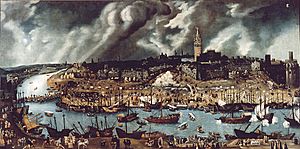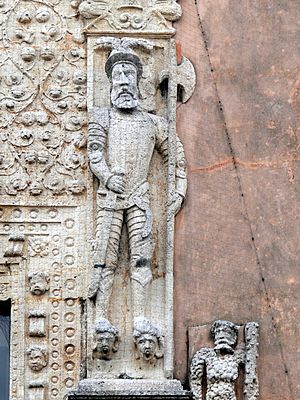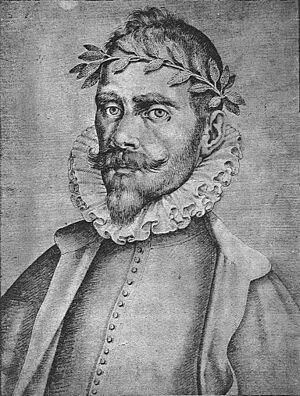Beltrán de Cetina facts for kids
Beltrán de Cetina y del Castillo (born in Alcalá de Henares, Spain, in 1521 – died in Mérida de Yucatán, Mexico, possibly in 1600) was an important figure during the Spanish conquest of the Americas. He was one of the first Spanish explorers and settlers, known as conquistadors, who helped establish the city of Mérida in what is now the Mexican state of Yucatán.
Beltrán came from a notable family. His brother was the famous Renaissance poet Gutierre de Cetina. His sister, Ana Andrea del Castillo, was also a conquistadora and married to Francisco de Montejo the Younger, another key leader in the conquest. Another brother, Gregorio de Cetina, also took part in the conquest of Yucatán.
Journey to New Spain

Beltrán's father, Beltrán de Cetina y Alcocer, was born around 1498. His family were hidalgo families, which meant they were part of the lower Spanish nobility. They had lived in Alcalá de Henares for a long time, but their family originally came from the village of Cetina in the Kingdom of Aragon.
Beltrán's father later moved to Seville, a big city in southern Spain. There, he married Francisca del Castillo y Zanabria in 1518. She was from Seville and her family might have had Morisco (Spanish Muslim converts to Christianity) roots.
The family lived in Seville, in an old area that used to be the Jewish quarter. Beltrán's father became a chief tax official and treasurer for Seville and its ports in 1536. This important job meant the family was well-off.
In 1535, Beltrán, his sister Andrea, and his cousin García del Castillo traveled across the ocean to New Spain (which is now Mexico). They were joined by their aunt, Antonia del Castillo.
The Cetina Family in the Americas
In 1539, Beltrán's sister, Andrea del Castillo, married Francisco de Montejo y León. This couple played a big part in founding and settling the city of Mérida. They had three children: Beatriz, Juan, and Francisca. Andrea was a strong woman. After her husband died, she bravely asked the King of Spain for a pension and the right to keep their properties in Mérida. One of these properties, the Casa de Montejo, was lived in by her family for centuries.
In 1541, Beltrán de Cetina y del Castillo was given an important role by his brother-in-law, Montejo "the Younger." He was made a civil and military leader (a capitán y justicia mayor) in the city of San Francisco de Campeche.
The next year, in January 1542, the city of Mérida was officially founded. Beltrán de Cetina was listed as one of its first citizens (vecinos). His role as a conquistador is recorded in lists of men who helped Montejo conquer Yucatán.
In 1547, Beltrán was chosen to be a regidor, or city councilman, by the main leader of the conquest, Francisco de Montejo y Álvarez de Tejeda.
Around this time, Beltrán's father wrote his will. He named his eight children as his main heirs. These included Gutierre, García del Castillo, Beltrán, Gregorio, Mencía de Santo Domingo Alcocer, Leonor, María del Castillo, and Ana Andrea del Castillo.
In 1550, Beltrán's brother, Gregorio de Cetina, got permission to travel to New Spain. He went with his cousins to help manage the properties of their uncle, Gonzalo López. This uncle had been a high-ranking officer (maestre de campo) during Hernán Cortés's Conquest of Mexico.
In 1553, two of Beltrán's nephews, also named Beltrán and Gregorio de Cetina y Velasco, traveled to New Spain. They became encomenderos, which meant they were given the right to collect tribute from local people in exchange for protecting them and teaching them about Christianity. They had many descendants in Yucatán, Tabasco, and Campeche.
Sadly, in 1554, Beltrán's poet brother, Gutierre, returned to Mexico. He died in Villa del Espíritu Santo from a face wound he received in Puebla. He was mistakenly attacked by a man who thought he was someone else.
Another sibling, García del Castillo, settled in Mexico City. He married Catalina López de Olivares and had children, including a son named Beltrán de Cetina who became a priest. María del Castillo, another sister, married a notable conquistador named Francisco Tamayo de Pacheco and settled in Mérida.
Gregorio de Zetina y del Castillo, who settled in Mérida, married Mariana de Quijada y Contreras. Her uncle was the alcalde mayor (a chief magistrate) of Yucatán from 1561–1565. Gregorio and Mariana had many children. Gregorio de Cetina also served as a steward (manager) of the chapel of San Juan Bautista in Mérida, which helped him financially.
Many members of the Cetina family and their relatives were among the first Spanish colonizers of Mexico and other lands. Their journeys and activities were recorded in Seville, Spain, at the Casa de Contratación de Indias, which was the main government agency for trade with the Americas.
See also
 In Spanish: Gregorio de Cetina para niños
In Spanish: Gregorio de Cetina para niños




